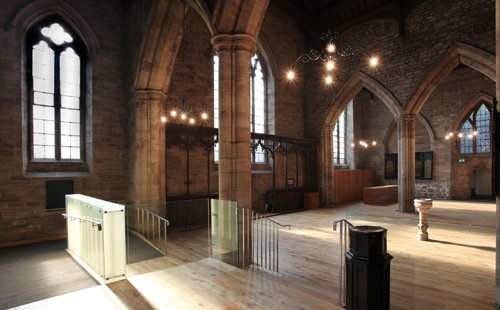Written by:
We are always keen to hear how independent practitioners are supporting and engaging with community-led and collaborative design projects in their work and to share some of their experiences and reflections with our audience.
In this think piece, architect Alex Coppock of Communion Architects shares his organisation’s approach to working with communities and how a shift in thinking has influenced how he works.
I first encountered The Glass-House in 2012 at a conference I was speaking at: the New Work in Churches conference organised by ChurchCare. The purpose of the day was to challenge thinking around how the Church meets the needs of its users and buildings. I met representatives from the charity again last year at a focus group organised by Empowering Design Practices for people providing professional advice and support to communities developing historic places of worship to meet wider community needs.
The approaches The Glass-House use when working with communities and which they outlined at both events struck a chord with me.
Part of my training was at the Sheffield School of Architecture, which has a noted focus on participative architecture. It’s a grounding that has stood me in good stead. The practice I founded, Communion Architects, has a specialism in church re-ordering and we have won several awards for our work.
Working with communities, as we do when working with church buildings, has unique challenges that are completely different to working with private clients and this is something that The Glass-House’s approaches recognise.
When you are working with an individual client or couple on a private project, you can have one-to-one conversations. These conversations ensure everyone has the time and space to articulate what they have in mind and to discuss and develop ideas through design conversations. The process means everyone fully understands the vision and we as architects can deliver a successful project.

When you are working with a community it is vital for the success of the project that there is the same openness of thought and intention among all the parties involved. But with so many stakeholders it is much harder to have the same intimate conversations. In other words, the need is still there, but the methodology isn’t.
So how do you get those conversations going? To help us create the best possible conditions to be able to deliver the desired outcome, we have developed a precise approach we use when asked to tender for work on church re-ordering projects.
We offer to convene a workshop with the community to consider the project in more detail. The workshop is offered free of charge, with the caveat that representatives from all stakeholders attend.
At the workshop, we explore the church building as a group and consider the problems that need to be solved. We then ask the participants to work either individually or in pairs to design their own solutions to the issue. Even when a brief has been agreed, written and submitted as part of the tender documentation it is astonishing – not least to the participants themselves – the differences in thinking.
The workshop provides insights that are not only valuable to Communion as we develop our own solution, but also for the community itself. It’s a process that starts to unlock the needs, wants and desires of a community and enables an holistic solution that is the shared vision of everyone in the community to be put together.
Having a shared vision creates a greater level of community participation and involvement and delivers a project that has more meaning for community members. This sense of ownership also helps to drive another factor that is key to the success of a community project: ensuring there is enough energy and impetus within the community itself to develop the project and keep it moving forward.
Developing this shared vision and sense of community ownership is central to the mission of The Glass-House and it’s why its work had such a powerful effect on me.
Alex Coppock is founder and director of Communion Architects
